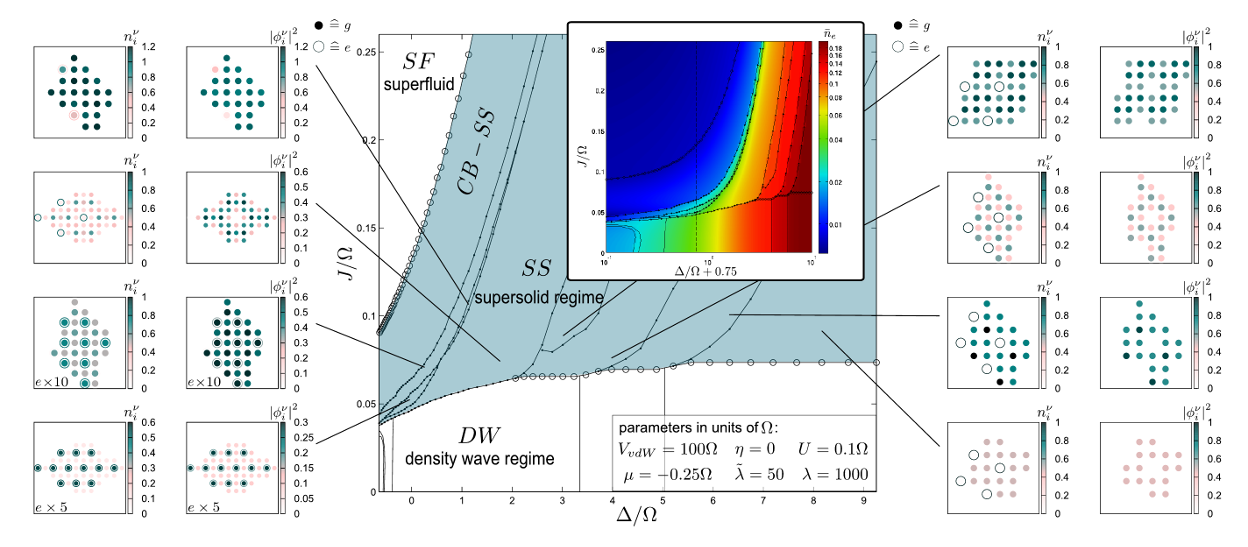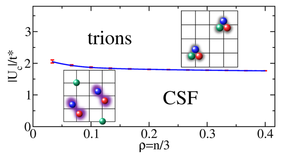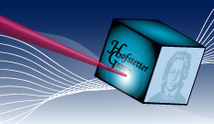Exotic phases
Superfluidity and Bose-Einstein Condensation (BEC) are very unusual and interesting phenomena. When a system of many bosons is brought to extremely low temperatures the atoms stop behaving as individual particles and start forming a macroscopic wavefunction. Effectively a large fraction of particles starts behaving as one. This has a significant influence on the behaviour of the system. E.g., it causes a phase transition to the BEC phase in an ensemble of noninteracting particles. Even more exotic behaviour occurs for interacting particles, where one can observe both BEC and the superfluid phase, characterized by zero viscosity, infinite heat conduction, etc. [1].
While the superfluid phase is certainly very interesting, it is also a complex phenomenon. Therefore it is alluring to study it on the optical lattice, where the system is both highly controllable and well described by the Bose-Hubbard model, fairly simple in form yet not trivial to solve. This field of research is developing extremely fast.
A new take on such experiments is to dress the atoms in optical lattices with Rydberg states. This adds a second species of bosons, which interact repulsively via the long-ranged van der Waals potential. Due to this interaction Rydberg atoms cannot be excited at the neighbouring sites and they are rearranged into a new periodic structure, breaking the translational symmetry of the underlying Hamiltonian. It has been predicted that a plethora of exotic phase can be observed in this system [2]. On top of already known superfluid and Mott insulating phases of the regular Bose-Hubbard model one finds density wave and supersolid phases, which can be realized in more than one way, as shown in Fig. 1.

Fig. 1. Phase diagram of the two-species extended Bose-Hubbard model with vdW-interacting excited Rydberg species. Figure taken from Ref. [2].
Superconductivity, which was discovered more than 100 years ago, is also a fascinating phenomenon and has inspired many developments in condensed matter physics. It occurs in some materials and it is based on forming a pair (Cooper pair) between spin-up and spin-down electrons. In 1957 Bardeen, Cooper and Schrieffer explained this pairing mechanism within their BCS theory, which up to date is one of the most successful theories in physics.
It turns out that this phenomenon is closely related to superfluidity. As these bound pairs of fermions are approximately bosonic in nature, they can form a condensate. More importantly they, also form a superfluid and therefore have all its properties, such as the zero-viscosity which explains the vanishing resistivity of the superconductor. It is remarkable that the concepts of superfluidity and superconductivity can also be applied in other fields of research, for example in high energy physics. As an example take quantum chromodynamics (QCD), in which it is expected that at large quark densities a colour superconducting phase emerges [3,4]. Due to this exchange of concepts between different branches of research new possibilities arise, e.g., that some aspects of high energy physics could be studied within condensed matter models. Particularly interesting is possibility of employing optical lattice experiments as quantum simulators [5-8].
In our research, trying to follow this path, we have explored a process in which a colour superfluid phase changes to a “barionic” (trionic) matter as the density of fermions is reduced [5]. This was done by investigating a Hubbard model with three species of fermions and attractive interaction. We observe that for low magnitudes of the attractive interaction the SU(3) symmetry is broken and two of three species of fermions form bosonic pairs which, in turn, leads to a superconducting phase. Upon increasing the strength of the interaction the superfluidity is lost due to formation of trions – bound triplets of fermions with different internal states. The phase diagram of this system is shown in Fig. 2 and can be compared to its QCD counterparts, as discussed in Ref. [5] .

Fig. 2. Phase diagram of the Hubbard model with three species of fermions and attractive interaction. Figure taken from Ref. [5].
[1] J. F. Annett, Superconductivity, Superfluids, and Condensates, Oxford University Press, Oxford (2004).
[2] A. Geißler, I. Vasic, and W. Hofstetter, arXiv 1509.06292 (2015).
[3] M. Alford, K. Rajagopal, and F. Wilczek, Phys. Lett. B 422, 247 (1998).
[4] D. H. Rischke, Prog. Part. Nucl. Phys. 52, 197 (2004).
[5] Á. Rapp, G. Zaránd, C. Honerkamp, and W. Hofstetter, Phys. Rev. Lett. 98, 160405 (2007).
[6] Á. Rapp, W. Hofstetter, and G. Zaránd, Phys. Rev. B 77, 144520 (2008).
[7] D. Gonzalez-Cuadra, E. Zohar, and J. I. Cirac, arXiv 1702.05492 (2017).
[8] F. Wilczek, Nat. Phys. 3, 375 (2007).





